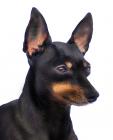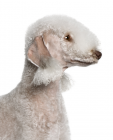Greyhound

In my own words
Most people think they know all about me, but there’s more to me than how fast I can run! I know it’s hard to believe with greyhounds racing around tracks in front of thousands of people, but I’m actually pretty shy. I like my home to be quiet and relaxed and while I do love a good sprint every day, I’m happiest lying around the hours and getting plenty of sleep – up to 18 hours every day! You might not think it, but I’m a complete couch potato at heart. I’m also very sensitive – I don’t like a lot of noise and I hate the cold; my lovely owner always makes sure I have an extra blanket when it’s chilly. Don’t be fooled by my sensitive temperament though, I’d still out run you in a race though!
My ideal owner(s)
People who enjoy walks
People who live in a temperate climate
Families with older children
Couples
Quiet households
Patient and sensitive owners
What they say about me
Quiet
Sensitive
Fast
Couch potato
Loyal
Affectionate
Please read on to find out more about me, and whether I’ll be someone you’ll be happy to live with for the next 13 years!
Is this Greyhound for you?
Test your knowledge about the Greyhound
Information essential about the Greyhound
Kennel Club Group:
Hound
Size:
Large: Weight Male 65 – 70 lbs (29 – 32 kg) Female 60 – 65 lbs (17 – 29 kg)
Height Male 26 – 30” (66 – 76 cm) Female 26 – 30” (66 – 76 cm)Popularity:
The greyhound has been primarily bred for racing, particularly in England. The popularity of the Greyhound as a racing dog has led to the breed being fairly popular in the UK, however its high exercise requirement prevents it from becoming an extremely popular pet even though the breed is well known.
Breed History:
It is often thought that Greyhounds originate from Ancient Egypt, where there are images of smooth coated sight hounds like the Saluki. However, modern DNA analysis has found that the Greyhound is not closely related to the Saluki and the breed is in fact more similar to herding breeds. It is more likely that the Greyhound originates from the ancient Celts in Eastern Europe, where dogs similar to the Greyhound were frequently bred in all sizes.
The Greyhound was originally bred to hunt in open spaces where their excellent eyesight and incredible speed gives them an advantage over other hunting dogs. Many experts believe that the breed was introduced to the UK from Celtic Europe in the 5th Century BCE, making the Greyhound a truly ancient breed.
The Greyhound was popular among hunters in the UK who used the dogs in the coursing of deer and later in hare coursing for sport and competitions. Greyhounds continued to be bred for hunting until the early 1900s when Greyhound racing was introduced. The breed also started to be seen for its companionship and owners began taking them on as pets and show dogs. In 1928, a greyhound called Primely Suare won the first ever Best in Show awards at Crufts. To this day many owners consider the Greyhound as a loving and affectionate pet away from the race track.
Character:
Your Greyhound is a quiet, contented and relaxed pet with plenty of love to give. Affectionate and with a wonderfully sweet nature, Greyhounds are incredibly loyal to their owners and love to be around their owners whenever they can be. A true companion animal, your Greyhound will be totally devoted to you! Despite their history as fast, sporty, racing dogs Greyhounds are very sensitive. They can be prone to separation anxiety and won’t do well with harsh or sever training – a soft, gentle yet firm approach with plenty of praise and rewards is best when training a Greyhound. Most Greyhounds will be good pets for families with older children, however their sensitive nature makes them best suited to quiet and calm households. Your Greyhound doesn’t tend to bark a lot and they tend to be friendly and welcoming to strangers providing they are with their owners at the time.
Temperament:
Due to the Greyhound’s background as a racing dog, it is often presumed that the breed is hyperactive. This however is not usually true. Greyhounds are excellent sprinters and incredibly fast, but they are more suited to short and fast bursts of activity than having a lot of stamina and endurance. Greyhound owners frequently describe their dogs as being couch potatoes. However, like any dog if the Greyhound is not given enough mental and physical stimulation he may become bored and come across as hyperactive or destructive as a way of entertaining himself. For this reason, they tend to be best suited to experienced dog owners who can give them all the stimulation they require. The greyhound’s relaxed and quiet nature means that they can be kept as apartment dogs, providing they have a good daily walk or run. Your Greyhound may well sleep for up to 18 hours per day and won’t need as much space as most large breeds. The Greyhound was originally bred to hunt and they still have an inherent desire to chase. Their strong prey drive means that they are best kept on a leash and are often not good pets for people who have smaller animals.
Conformation:
The Greyhound has a distinctive appearance in that it is tall and lean. The body is highly contoured and has a long look with a deep chest and muscled neck. The head is long with a tapered muzzle, folded ears and dark, round eyes. Built for speed, the Greyhound’s legs are straight at the front with hare like feet and the hindquarters are muscular and strong. The tail is carried low, curving slightly at the end. The coat is smooth and short.
Colour:
Despite its name, the Greyhound does not just come in grey. The coat can be any colour including blue, white, brindle, black and fawn.
Training:
Your Greyhound has a very sensitive nature and will become upset if you lose your patience with him or use severe methods during training. Treating a Greyhound harshly can cause him psychological trauma, so it is extremely important that you are gentle with your Greyhound when you train him and remain patient, calm and consistent. Plenty of praise and treats will help your training sessions go well and you will find your Greyhound picks up new training relatively easy with the right training methods. As Greyhounds are naturally shy they must be socialised with people, dogs and other animals from an early age to prevent timidness and fear of strangers.
Care:
The Greyhound’s short coat is prone to shedding, so a daily brush with a mitt will control the shedding while keeping the house relatively free of loose dog hair. Bathe your dog only when necessary to prevent skin conditions from arising, you may even prefer to use a dry shampoo. The Greyhound’s teeth should be brush several times every week as the breed is prone to dental issues.
Health:
The average lifespan of the Greyhound is 10 to 13 years. Hereditary illnesses in Greyhounds are rare, however some Greyhounds have been known to develop esophegael achalasia, osteosarcoma and bloat. The Greyhound’s svelte body means that the dogs are uncomfortable sleeping on hard floors and can develop sores if they are not provided with plush bedding. Your Greyhound is also very susceptible to insecticides including flea collars and flea spray if the formula contains pyrethrin. As your Greyhound is so lean and does not have an undercoat he is very susceptible to extreme temperatures and must be given extra warmth in cold weather and kept cool in hot weather.
You may also like:
Greyhounds looking for a home in UK »




Greyhounds and their owners »

If you like Greyhounds, you may be interested in breeds of the same size »





If you like Greyhounds, you may like other breeds with similar characteristics »





Advice on choosing your breed »
Find an animal shelter or rescue home where a Greyhound is waiting for a new home »
The following grid gives a fast track review which covers all breeds. You can apply it to help you decide if a Greyhound is suitable for you, the environment where you live, your personality and your lifestyle. On the grid, 1 = strongly disagree, and 5 = strongly agree. For example, if you are looking for a dog that is suitable for apartment living, look down the list under ‘environment’ and you will see that Greyhounds are a good choice for urban living, scoring 5. If you are looking for a dog that would make a good watch dog, look under ‘role and suitability’ and you’ll see a Greyhound would not be a good choice, scoring 1. You might like to save or print off this section and keep it for reference while you check some other breeds before making your choice.
Be the first to rate this breed »
|
*PLEASE NOTE: All our breed profiles are general, and all dogs are individuals. Always talk to the breeders and meet the owners you are buying from. Try to meet the dog and its parents if it is a puppy in their home environment.














